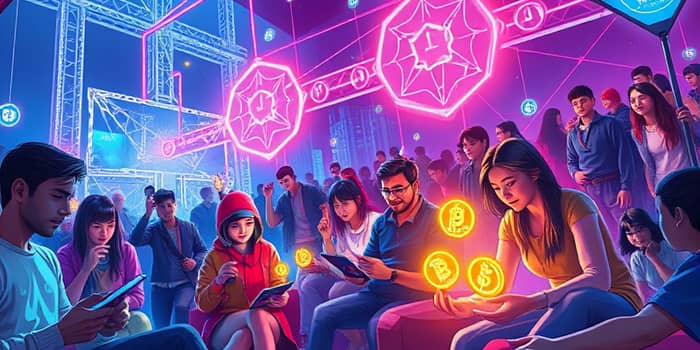In recent years, gaming has transcended entertainment, evolving into a bustling marketplace where players can earn digital assets with genuine financial stakes. This new frontier, known as play-to-earn (P2E) gaming, leverages blockchain technology to create player-owned economies that reward skill, time, and creativity.
By redistributing value to participants, P2E titles redefine the traditional developer-player relationship, fostering a sense of ownership and active involvement in the game’s success.
Definition and Overview
At its core, play-to-earn gaming is a paradigm where participants engage in in-game activities—such as completing quests, winning battles, or trading virtual items—to receive rewards that carry real-world value. Unlike traditional games, where progress and assets are confined to a closed system, P2E titles record ownership on a transparent blockchain ledger, ensuring true digital ownership and enabling frictionless trade across platforms.
Blockchain infrastructure provides the backbone for these experiences, offering security, auditability, and decentralized exchange. Popular networks include Ethereum, BNB Chain, Solana, and Polygon, each vying to balance scalability with low transaction costs.
Core Components of Play-to-Earn Games
- NFT-Based Assets: Unique tokens represent characters, land parcels, or collectibles.
- Token Economy: In-game currencies that players can swap for cryptocurrency or fiat.
- Decentralized Governance: Community voting via governance tokens on updates and policies.
- DeFi Integration: Staking and yield farming mechanics for additional rewards.
- Interoperability: Transferable assets that move between supported games.
These elements combine to form ecosystems where both gamers and developers benefit. Players gain autonomy over their assets, while studios monetize through NFT sales, marketplace fees, and community-driven funding rounds.
How the Model Works
Gameplay loops in P2E titles typically revolve around earning rewards through skill-based or time-based activities. For example, in Axie Infinity, users breed and battle digital creatures called Axies to earn SLP tokens. These tokens can then be traded on exchanges or reinvested to acquire rare NFTs.
Developers generate revenue by selling starter packs, taking transaction fees in secondary marketplaces, or issuing governance tokens that appreciate with network growth. This dual-sided incentive model fosters a dynamic ecosystem where both sides thrive.
Market Size and Growth
The play-to-earn sector represents a significant portion of blockchain gaming. Estimates for the global market size in 2025 range from $13.97 billion to $24.4 billion, reflecting rapid adoption and diverse methodologies. Projections suggest an expansion to anywhere between $109.66 billion and $1.17 trillion by early 2030s, driven by a compound annual growth rate (CAGR) exceeding 44%.
Play-to-earn titles currently account for 62% of blockchain gaming revenue, highlighting their dominance in the sector. Mobile platforms drive much of this activity, representing between 55% and 73% of all P2E games, thanks to widespread smartphone penetration.
Geographically, regional adoption varies:
- Asia-Pacific: 28.7%–47% share
- North America: 31% share
- Europe: 14% share
- Oceania: 4% share
Technological Trends & Game Design
Innovations in the blockchain space are reshaping how games are built and experienced. Metaverse integration is on the rise, with 37% of new titles featuring immersive social environments where avatars interact, attend events, or trade digital goods.
Advancements in layer-2 scaling solutions and cross-chain bridges improve transaction throughput and reduce fees, making everyday trading seamless. Interoperable assets now allow characters and items to move across supported titles, offering unprecedented continuity in player progression.
Notable Games and Mechanics
Several pioneering titles illustrate the diversity and potential of play-to-earn models:
Axie Infinity: Players breed, battle, and trade Axie creatures, earning tokens convertible to fiat. Community-driven scholarship programs provide new users with starter assets at no cost.
Sorare: A fantasy football game where users collect officially licensed player cards as NFTs, competing in leagues to earn ETH rewards based on performance.
League of Kingdoms: A strategy title where land ownership, resource production, and alliance-building occur on a decentralized map, rewarding governance and territorial control.
Economic and Social Impacts
In regions with limited economic opportunities, play-to-earn games have become vital income sources. Dedicated players in the Philippines, Venezuela, and parts of Africa sometimes earn above local average wages, supporting families and funding education.
Decentralized governance empowers communities to influence game roadmaps. While the effectiveness of these systems varies, successful projects demonstrate how community-led decision making fosters sustainable growth and player loyalty.
Challenges and Criticisms
Despite promise, the P2E model faces hurdles:
Volatility: Asset values can swing wildly, potentially leaving players with negligible returns.
Sustainability Concerns: Economies reliant on continuous new users risk collapse if growth plateaus.
Regulatory Uncertainty: Governments are still crafting rules around crypto earnings, NFTs, and in-game transactions.
Security Risks: Smart contract bugs and scams can jeopardize player assets.
Entry Barriers: High initial costs deter casual gamers; scholarship and lending programs aim to mitigate these obstacles.
Future Outlook
Continued investment from venture capital and major tech firms signals confidence in blockchain gaming’s long-term potential. Innovations in DeFi-NFT hybrids, cross-chain interoperability, and immersive virtual worlds will drive next-generation P2E experiences.
As gameplay quality improves and economic models mature, the industry is poised to capture mainstream audiences. By blending engaging entertainment with economic opportunity, play-to-earn gaming stands to redefine digital interaction and empower a new wave of global participants.
In the evolving landscape of digital entertainment, P2E models represent a powerful intersection of technology, economy, and community. For players and developers alike, the promise of ownership, transparency, and financial participation marks a transformative step forward.
Whether you are a seasoned blockchain enthusiast or a curious newcomer, exploring play-to-earn titles offers both a thrilling gaming experience and the opportunity to partake in burgeoning digital economies. The game has changed: it’s time to claim your stake.
References
- https://blog.coinremitter.com/understanding-play-to-earn-gaming-model/
- https://www.imarcgroup.com/blockchain-gaming-market
- https://www.kraken.com/learn/what-play-to-earn-crypto-games
- https://coinlaw.io/crypto-gaming-statistics/
- https://hedera.com/learning/gaming/crypto-gaming
- https://www.coherentmarketinsights.com/industry-reports/blockchain-gaming-market
- https://gam3s.gg/news/play-to-earn-business-model-explained/
- https://www.360iresearch.com/library/intelligence/blockchain-gaming










